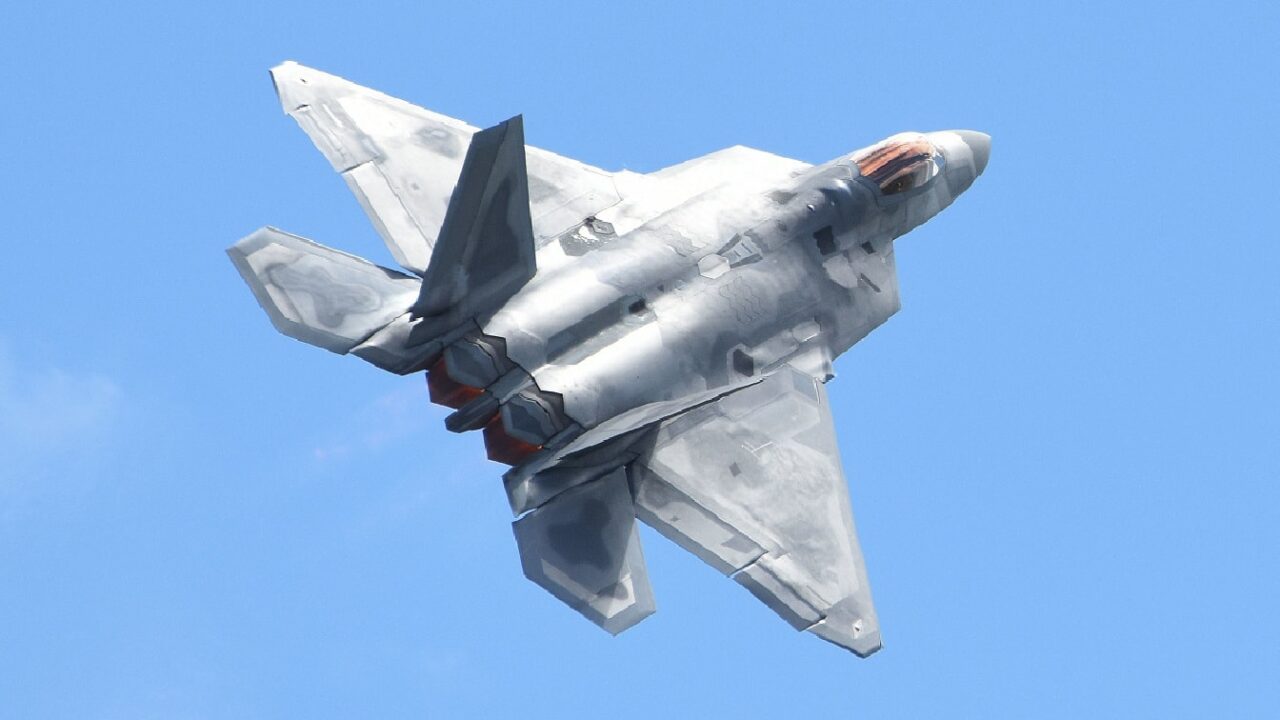The arrival of U.S. Air Force F-22s at an undisclosed base in the Middle East is a major development, placing 5th-generation stealth aircraft in close proximity to Iranian and Syrian airspace where Russian fighter jets have been provoking U.S. F-16s.
Middle East Air Activity
Both Russian and U.S. fighter jets operate in the skies above Syria given the ongoing conflict in the area, yet there have been clear, measurable guidelines and restrictions in place to ensure stability between the two great powers and prevent the possibility of a miscalculation or unintended conflict.
However, U.S. Central Command is sending a clear message by deploying F-22s as a security measure after experiencing “unprofessional” and provocative behavior by Russian fighter jets over Syria.
Several U.S. Air Force videos released in April show two Russian Su-35s veering dangerously close to US F-16s, incidents recorded by F-16 cameras. When discussing the incident on NBC news, Lt. Gen. Alexus Grynkewich, Combined Forces Air Component Commander for U.S. Central Command, said Russian planes made dangerous maneuvers when they came within 500 feet of U.S. F-16 aircraft. This is a direct and flagrant violation of existing rules and protocols, which specify a need for “miles wide” deconfliction zones, according to an article in the Air Force Times, which also says U.S. and Russian air commanders share a “hotline” to discuss and avoid miscalculations.
Multiple news reports speculate that the Russian provocations are in part related to its growing connection with Iran, given Iran’s support to Russia in its war with Ukraine. An interesting article from Maya Carlin in 19FortyFive says Tehran has become a leading supplier of unmanned combat systems to Russia during the Ukraine war, a fact that may help explain why Russia appears to be showing greater solidarity with Iran.
The provocative maneuvers with Russian Su-35s do appear quite serious, as Su-35s are among Russia’s most advanced and highly upgraded 4th-generation ++++ aircraft. Building upon the Su-27 and Su-30, the Russian Su-35 is described in the Russian press as a “heavily upgraded,” “maneuverable” multi-purpose fighter with many 5th-gen-like attributes.
A Russian TASS News agency report says the Su-35 was developed on the “basis of 5th-generation technologies.” This includes new avionics, radar, and what TASS refers to as “plasma ignition engines” to increase thrust vectoring. This technology, according to TASS, reportedly gives the Su-35 an F-22-like ability to achieve supersonic speeds without needing an afterburner.
Su-35 vs F-22
Some of the most specific available research on the Su-35 is shared in a 2020 report titled “Famous Russian Aircraft – Sukhoi Su-27 and 30/33/34/35,” which describes how this cutting-edge radar can track an aerial target at ranges up to 250 miles and simultaneously track eight enemy targets at the same time.
The text, written by Yefim Gordon and Dimitry Komissarov, also says the Su-35S is engineered with some “stealthy-like” radar-absorbent materials in specific front-end locations such as the engine inlets and compressor, and the craft is outfitted with other radar cross-section reducing technologies.
These factors may well help explain why the Pentagon is now placing F-22s within reach of Syrian airspace, as it would seem unlikely that an upgraded Russian Su-35 could prove superior to U.S. Air Force F-22s. By contrast, should Russia’s claims regarding upgrades and capabilities related to the Su-35 be accurate, it is realistic to consider that the Russian Su-35 might be superior to even upgraded U.S. F-16s operating over Syria. The arrival of F-22s, therefore, is likely intended to help ensure U.S. Air Force overmatch in the region.
U.S. Air Force F-22s, in particular, are the focus of a critical rapid deployment readiness program known as “Rapid Raptor.” This effort, in place for many years now, is designed to ensure that F-22s can successfully deploy for combat missions anywhere in the world within 24 hours. This is intended to guarantee rapid response and ensure the F-22 can align with its key mission to perform the “first-strike, first-kill” offensive air combat capability.
Kris Osborn is the Military Affairs Editor of 19FortyFive and President of Warrior Maven – Center for Military Modernization. Osborn previously served at the Pentagon as a Highly Qualified Expert with the Office of the Assistant Secretary of the Army—Acquisition, Logistics & Technology. Osborn has also worked as an anchor and on-air military specialist at national TV networks. He has appeared as a guest military expert on Fox News, MSNBC, The Military Channel, and The History Channel. He also has a Masters Degree in Comparative Literature from Columbia University.
From 19ForytFive
Footage Shows World War I Guns Being Used in Ukraine
‘Vacuum Bombs Destroyed’: Ukraine Footage Shows Putin’s Thermobaric Rockets Destroyed
BOOM! Ukraine Video Shows Precision Strike on Russian Air-Defense System

